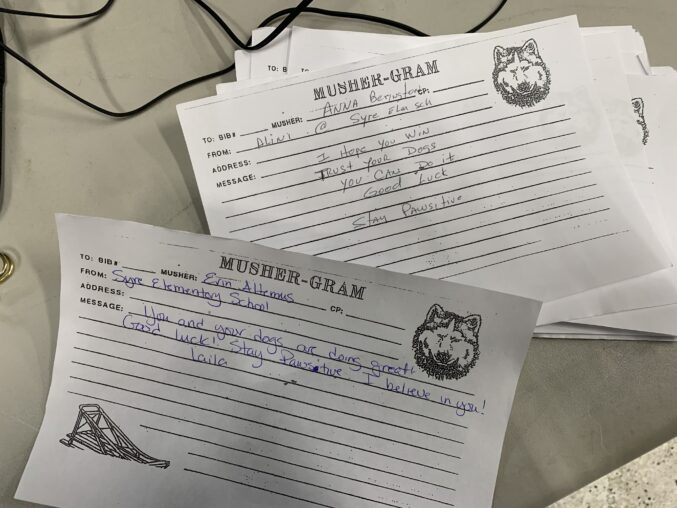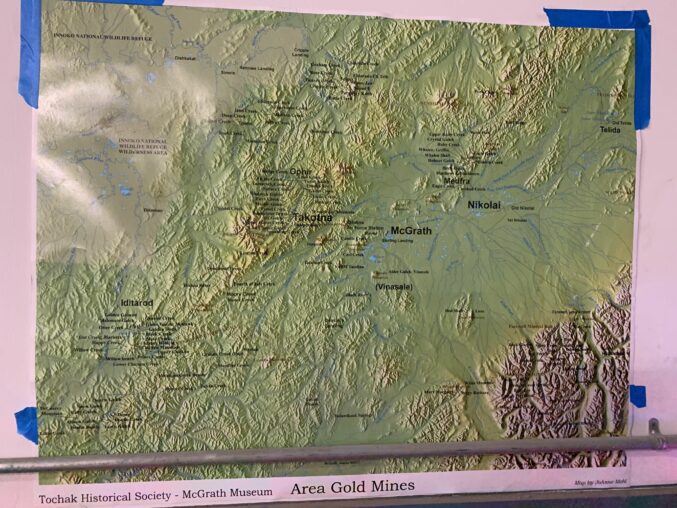“This is why I’ve been doing this for forty years,” Mark Nordman said, nodding at some school kids animatedly talking across the shop in McGrath where the checkpoint is located. Iditarod finisher, Race Marshal for many years, and all around amazing person, Nordman has been up and down the Iditarod Trail more than anyone.
It’s 8:50 pm and Sailor, McKayla, Sophia, Emerie and Sandy are hanging out at the checkpoint—partly because there’s candy, and partly because there are new people to talk to from outside of town. I’m not the only 5th grade teacher here—Wendy is working the trail crew and teaches 5th grade in Erie, Colorado. Working with checkers Dianna and Katie has been really fun, too. Dianna lives at the South Pass City State Historic Site in Wyoming, where an important gold mining town was established in 1868.
What the people gathered here have in common is that they have come to the Iditarod from near and far to help work the race, to cheer on the mushers, and to make sure all the mushers and their dogs have a great experience. And they are from all over the United States, even from around the world. Which leads me to my lesson connection—geography.

Local people and trail volunteers from many places gather in McGrath. Photo: K. Newmyer
Geography is a really fun subject to teach. Starting with the Iditarod Trail, students can learn the difference between air miles and trail miles. Which is longer, and why? Students can compare the differences between checkpoints and figure out why a checkpoint might be located where it is. What is the population of each checkpoint? What are the coordinates of each checkpoint on the map?
You can also use the Iditarod to teach about urban, rural, and suburban environments. The race starts in downtown Anchorage, a big city, and winds its way out of town through a small suburban area to the Campbell Airstrip. Then for most of the rest of the way, the race is solidly in rural territory. Talk about the characteristics of each location and share photos—then ask students what they notice.
Another great way to teach geography is to locate on a map where all of this year’s mushers are from—especially if you teach U.S. History. Display a U.S. map and have students locate where the mushers grew up or where they live now. Create a graph of the locations and see which one has the most. Research a little about the places where mushers and volunteers come from using town web sites and other sources. Compare and contrast these locations to Iditarod Trail checkpoints. Another great connection is Mushergrams. Students and fans from all over the U.S. can call in and have a volunteer write down your note for a musher. As the teams check into McGrath, I’ve had the fun of bringing the Mushergrams to each recipient.

Mushergrams are a great way for people around the world to send encouragement to mushers. Photo: K. Newmyer
Integrating descriptions and stories into your study of geography will deepen students’ understanding of the different places. For example, I asked the Alaskan students hanging out in the checkpoint building what they like about Alaska—and all of them said the winter cold, snowmachining, and playing in the snow. You can write descriptions of the Iditarod checkpoints based on the photographs on the Iditarod web site. Describe what it would be like to live there.
Using the trail descriptions that I mentioned in my post about trail markers, you can have your art students create landscape images of the various scenic places that mushers go through on the trail. Mountains, forests, frozen rivers, flat places with little snow, tricky mountain drops, and icy places where the wind blows would all be great inspiration for paintings and drawings. Create an Iditarod Trail for your PE class or Field Day, and instead of using checkpoint names, use geographic features found on the trail—Dalzell Gorge, Farewell Burn, Bering Sea Coast. Maybe they run the number of yards equal to the miles between checkpoints or challenge them to travel between several checkpoints before stopping to rest. Music classes can write song lyrics or tunes that describe the geography of the places on the Iditarod Trail (similar to the song America the Beautiful).
So far, I’ve traveled to several places on the Iditarod Trail and each one is unique and different. Flying from Anchorage to Willow for the restart, then to Skwentna, took me over frozen lakes, rivers, and forests of evergreen trees covered in snow. Today, flying from Anchorage to McGrath in a commercial 7-passenger aircraft, we were able to go right over the mountain range and roughly follow the trail the mushers take to this village checkpoint. Studying a topographic map—one that shows landforms—in the checkpoint, I was able to recognize the route we flew into this old Alaska gold mining district.

A map in the McGrath checkpoint showing the topography of the mining area. Photo: K. Newmyer
The Iditarod is a great entry point for students to study geography. The local school kids I met have a great attitude: embrace the features of the place where you live and stay up late when the Iditarod comes to town! How do you use the Iditarod to teach geography? Email me at emailtheteacher@iditarod.com.


